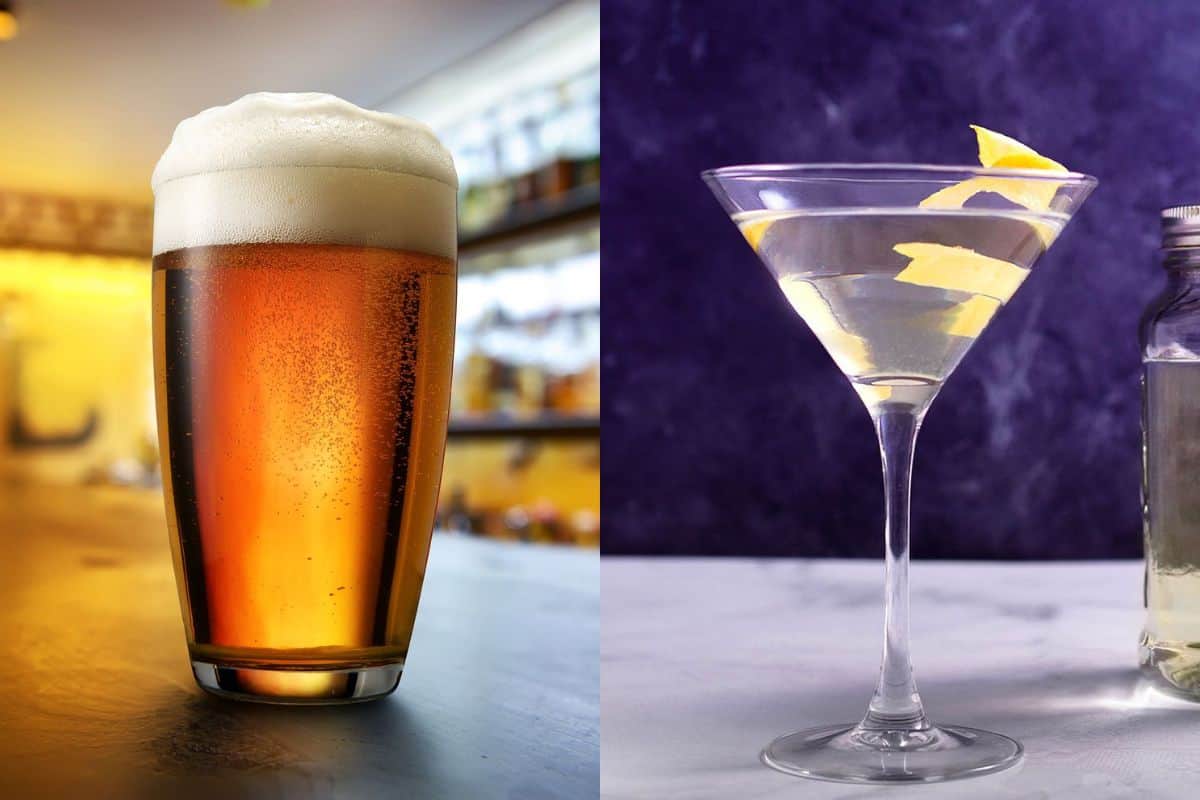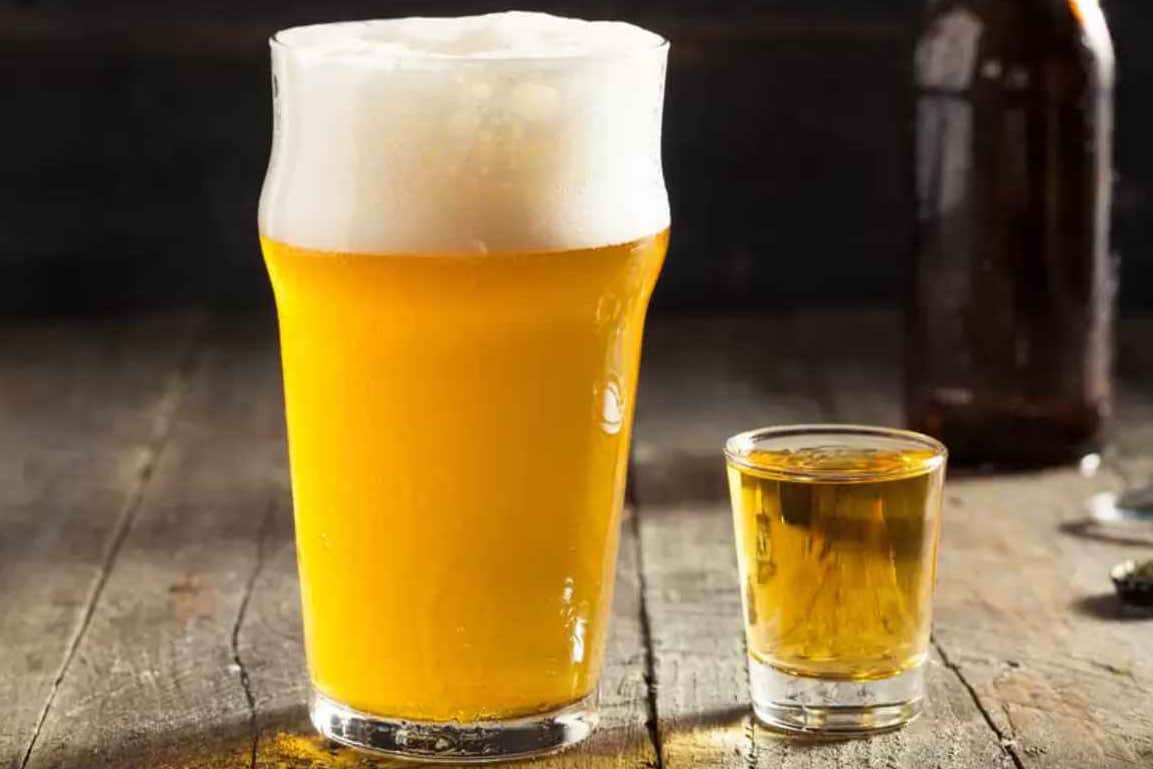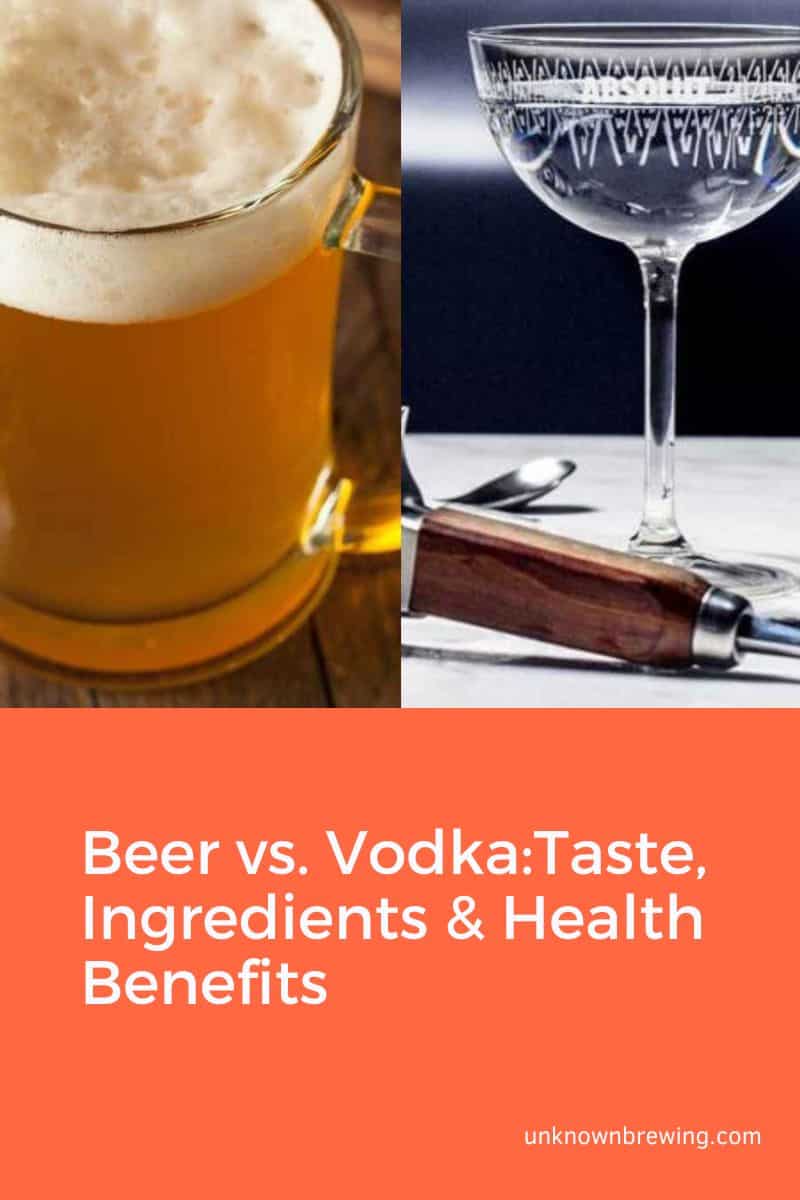No debate is as furious in nightclubs, bars, and pubs as beer vs. vodka. While both sides bring forth good points, is there a better option between the two?
In this article, we’ll be pitting beer against vodka. We’ll examine different aspects of both beverages, including ingredients, brewing process, appearance, and taste. Without further ado, beer vs vodka.
Beer vs. Vodka: Ingredients
Beer is typically brewed from four main ingredients; malted grains, hops, water, and yeast. Malted grains provide sugar for the yeast to process into alcohol and carbon dioxide gas. Hops provide flavoring for beer, and water holds everything together.
There are many grains that you can malt to brew beer. Barley is widely used because of its sugar and protein content. Barley forms the base of many beer recipes. Other grains commonly used to supplement barley include wheat and rye.
However, other beer styles require the inclusion of grains like corn or rice. Gluten-free beers avoid barley, wheat, and rye due to their gluten content. Gluten-free brewing uses gluten-free grains like sorghum, millet, oats, corn, buckwheat, and rice.
Other beer styles, like meads, trade malted grains for fruits and honey. To learn more about meads, check out our article on metheglin.
Vodka is distilled from grains or potatoes. The grains or potatoes provide sugar which yeast converts to alcohol (ethanol). To help with starch breakdown, distillers add food-grade amylase enzymes. The brewer then distills the alcohol to strengthen it.
Vodka production doesn’t malt its grains. Common grains used in vodka production include:
- Wheat
- Rye
- Sorghum
- Corn
- Rice
Vodka is more versatile in terms of ingredients. Distillers can use molasses, table sugar, and fruits as alternatives to potatoes and grains.
Beer and Vodka Ingredients Key Differences: While vodka and beer production can involve grains, beer brewing requires malting. Malting mobilizes the grains’ natural enzymes, a key player in mashing. Vodka production compensates for the lack of these enzymes by adding food-grade amylase enzymes. Vodka can use potatoes in its production, while beer can’t.
Beer vs. Vodka: Brewing/Distillation Process
Beer brewing involves several steps. First, malted grains are crushed and then soaked in hot water. The hot water facilitates the breakdown of starches in the malt into simple fermentable sugars. These sugars dissolve in hot water to form a sweet liquid called wort.
The brewer then separates clear wort from the spent grains in a process we call lautering. The brewer adds hops to the clear wort and boils the mixture to extract flavor. After boiling, the brewer separates the spent hops from the wort and lets it cool.
Upon cooling, the brewer adds yeast to the wort and lets it ferment. Beer fermentation can take several weeks to complete.
Vodka production involves distillation, a process that concentrates alcohol content. First, the grains or potatoes are shredded and mixed in water to form a mash. Amylase enzymes are also added to the mixture. When using crushed malted barley, wheat, or rye, you don’t have to add enzymes.
The distiller heats this mash for about two hours. Once the time elapses, the distiller strains the mash with a cheesecloth or filter. This action separates the wort from the spent potato and grain residue.
The distiller then pitches yeast to initiate fermentation. In this process, yeast converts the sugars in the wort to ethanol and carbon dioxide gas. Fermentation runs for three to five days.
As fermentation concludes, the yeast settles at the bottom of the vessel. The distiller filters out the sediments to separate them from the newly-brewed alcohol.
The brewer distills this alcohol by boiling it and collecting its vapor. The condensed vapor has a higher alcohol content. The first few ounces of distillate are discarded as they may contain harmful methanol. After that, the distiller collects vodka. Vodka can be distilled for several rounds to improve quality and alcohol content.
Beer and Vodka Production Processes Key Differences: Beer brewing ends with fermentation. Vodka production involves distillation after fermentation.
Beer vs. Vodka: Alcohol Content
While beer and vodka are both alcoholic beverages, they contain different levels of alcohol. The alcohol content of beer varies widely depending on the beer style and the brewing process.
Alcohol laws in certain jurisdictions can also restrict beer alcohol levels. Beer alcohol content levels typically range from 2-12% ABV. But most beers contain between 4-8% (ABV).
Below is a list of typical alcohol levels for various beer styles:
| Beer Style | Alcohol Content (% ABV) |
| Sours | 3.0 – 5.0% |
| Wheat Beers | 3.5 – 5.6% |
| Pilsners | 4.1 – 5.3% |
| English Pale Ales | 4.5 – 5.5% |
| American Pale Ales | 4.4 – 5.5% |
| Hefeweizens | 4.9 – 5.6% |
| Amber Ales | 4.4 – 6.1% |
| Stouts | 4.0 – 9.0% |
| Porters | 4.5 – 6.0% |
| India Pale Ales (IPAs) | 6.3 – 7.5% |
| Imperial IPAs | 7.0 – 14% |
In terms of alcohol content, vodkas are stronger than beers. In America, vodkas have an alcohol content level of at least 40% ABV. In Europe, vodkas of 37.5% ABV are acceptable.
Beer and Vodka Alcohol Content Key Differences: Beers have lower alcohol content levels than vodkas. A beer’s alcohol strength ranges from 2-12% ABV, but most contain 4-8% ABV. In America, vodka must attain at least 40% ABV for consideration.
Beer vs. Vodka: Health Benefits and Risks
Beer contains many nutrients that could benefit your body. Many researchers believe moderate beer drinking can reduce the chance of heart disease. Beer can improve the antioxidant properties of HDL cholesterol. HDL is a good cholesterol that can help eliminate harmful forms of cholesterol.
Beer can also improve your body’s blood sugar control. Several studies have shown that moderate drinking (a beer or two per day) can reduce insulin resistance. This is a condition that causes type 2 diabetes.
Beer is brewed from water that’s rich in calcium. Calcium is an essential nutrient that helps with bone density.
While beer can benefit your body, excessive drinking harms your health. Below are some health risks that come with binge drinking:
- Depression
- Liver disease
- Weight gain
- Cancer
- Death
Vodka also has health benefits. It is a strong alcohol, making it a powerful antiseptic. You can use vodka to sanitize wounds and sterilize medical equipment. Vodka also contains ethyl alcohol, a pain killer that can quiet toothaches.
In comparison to beer, vodka has a lower calorie count. Technically it’s a healthier alternative to beer and other forms of alcohol.
Excessive consumption of vodka can increase the risks of:
- High blood pressure
- Stroke
- Heart attack
- Irregular heartbeat
- Death
Beer and Vodka Health Benefits Key Differences: Vodka is a stronger alcohol than beer. As such, it has better antiseptic properties. Beer isn’t strong enough to kill germs. Vodka contains ethyl alcohol which has analgesic properties. In other words, you can use vodka as a painkiller. In terms of nutrition, beer has more nutrients that benefit the body. It contains protein for cell regeneration and calcium for bone development. However, beer generally has more calories than vodka.
Beer and Vodka Health Risks Key Differences: As alcoholic beverages, beer and vodka have similar health risks. Vodka’s health risks may be more severe because it is a stronger alcoholic drink.
Beer vs. Vodka: Taste
Beers extract their flavors and aromas from their ingredients. Malted grains give beers a malty flavor that ranges from biscuity to chocolate. Malted grains can also give beers a sweet finish.
Hops impart a wide variety of flavors, including:
- Earthy
- Floral
- Spicy
- Herbal
- Fruity
- Woody
Yeast can also impart flavor to your beer, typically earthy, fruity, and spicy. Beer carbonation also has an impact on its taste. As it fizzes on your tongue, beer gives an impression of bitterness. Hops also add bitterness to beer. The taste of a particular beer depends on the ingredients used and its brewing style.
In comparison to beer, vodka is lacking in taste. Vodkas are drier than beers. The dryness increases the vodka’s perceived bitterness. SSome vodka brands add artificial flavoring to improve the taste of the liquor. Common flavor additions include citrus, strawberry, and apple.
Vodka and Beer Taste Key Differences: Beer is more versatile in terms of taste. Beer extracts its flavor from its ingredients and brewing process. Different ingredient combinations yield different flavor profiles. Vodka, on the other hand, has a dry taste that lacks flavor.
Beer vs. Vodka: Appearance
Beer comes in many colors. It ranges from pale (golden) to amber to black. The color of a beer depends on the style. Lagers, pilsners, and pale ales are usually pale (golden to amber). Porters and stouts are dark beers. Their colors range from brown to black.
Beers also have different clarity profiles. Some beers a clear enough to see through them, while others are hazy. Other beers are so dark that you cannot see through them. Lagers often have clear profiles, while wheat beers are hazy.
Vodkas are colorless and crystal clear. Some come in pink, green, or blue hues. But these examples have been modified to match the flavor of the vodka.
Beer and Vodka Appearance Key Differences: Vodkas are almost always colorless and crystal clear. Beers are more diverse in terms of color and clarity. Generally, beer color ranges from pale (golden or amber) to dark (black or brown).
Beer vs. Vodka: Final Thoughts
Beers and vodkas are both alcoholic drinks, but the similarities end there. They differ in appearance, taste, alcohol content, and brewing process. Knowing the differences between beer and vodka inform your decision as you look to try either.
Is beer better than vodka? Beer is better in certain aspects. Beer tastes better than vodka. It also has a lower alcohol strength making it better for light drinking on certain occasions. Vodka is better than beer in certain aspects. For example, vodka has a low-calorie count, making it the healthier of the pair.

As a homebrewer, Michael would get frustrated about the lack of brewing information on the internet. After hundreds of gallons of spoilt batches, Micheal had enough. And he founded Unknown Brewing as a resource for homebrewers.








Great Content!
Thanks for sharing!